Washington, D.C. is home to over 150 monuments and memorials. They’re all over the place! But the ones that are most visited tend to be those honoring political icons of and pivotal events in American history. These 16 are the best monuments and memorials in Washington, D.C. and are worthy of a visit when in the nation’s capital. Pick out the ones that speak the most to you — or visit them all!
The monuments often communicate with their viewers — in a literal and/or figurative sense. Sometimes visitors can read inscribed quotes by those memorialized or view the names of those who died fighting for the country at war memorials. And that communication can also come when visitors ponder the strong symbolism projected by a monument or memorial (such as those honoring Dwight D. Eisenhower; Franklin D. Roosevelt; and Martin Luther King, Jr.).
However a person or event is depicted in a monument or memorial, it’s time to pause and think about those who came before us and worked to make their country — and the world, in some cases — a better place.
The Best Monuments and Memorials in D.C.
The monuments and memorials that top most visitors’ lists are these 16 — and for good reason. All of them help us to remember our nation’s history. It needs to be stated that much has been made of some historical facts that are troubling to today’s citizens such as the fact that some of our famous leaders enslaved others. There’s no denying that slavery was an awful blemish on the country’s past and that of our world dating back to the beginning of recorded history. (As a result, I try to maintain an accurate and complete perspective on what is presented.)
These 16 monuments and memorials are listed in alphabetical order for ease of reference. To plan which ones you will visit, the National Park Service map may help. Most are clustered around the National Mall area. There are no fees to view any of the monuments or memorials listed in this post.
1. Arlington National Cemetery
Arlington National Cemetery had its beginnings as an estate overlooking Washington, D.C.
Brief History
George Washington’s adopted grandson, George Washington Parke Custis, established Arlington House as a way to honor the Founding Father. George Custis’s daughter, Mary, married Robert E. Lee, a West Point Academy graduate. Lee was the man who turned down President Lincoln’s offer to lead the Union Army in 1861 at the beginning of the country’s Civil War. Instead, Lee became General of the Confederate States and led the southern states that wanted to secede from the United States and form their own country. Mary later inherited Arlington House upon her father’s death.
In 1861, the federal government seized the property to defend the city; the Arlington House estate was in such close proximity to the capital. The grounds became the site of a Union Army headquarters — and soon thereafter a burial ground. (It should be noted that the federal government did purchase the property from the Custis/Lee family after the Civil War.)
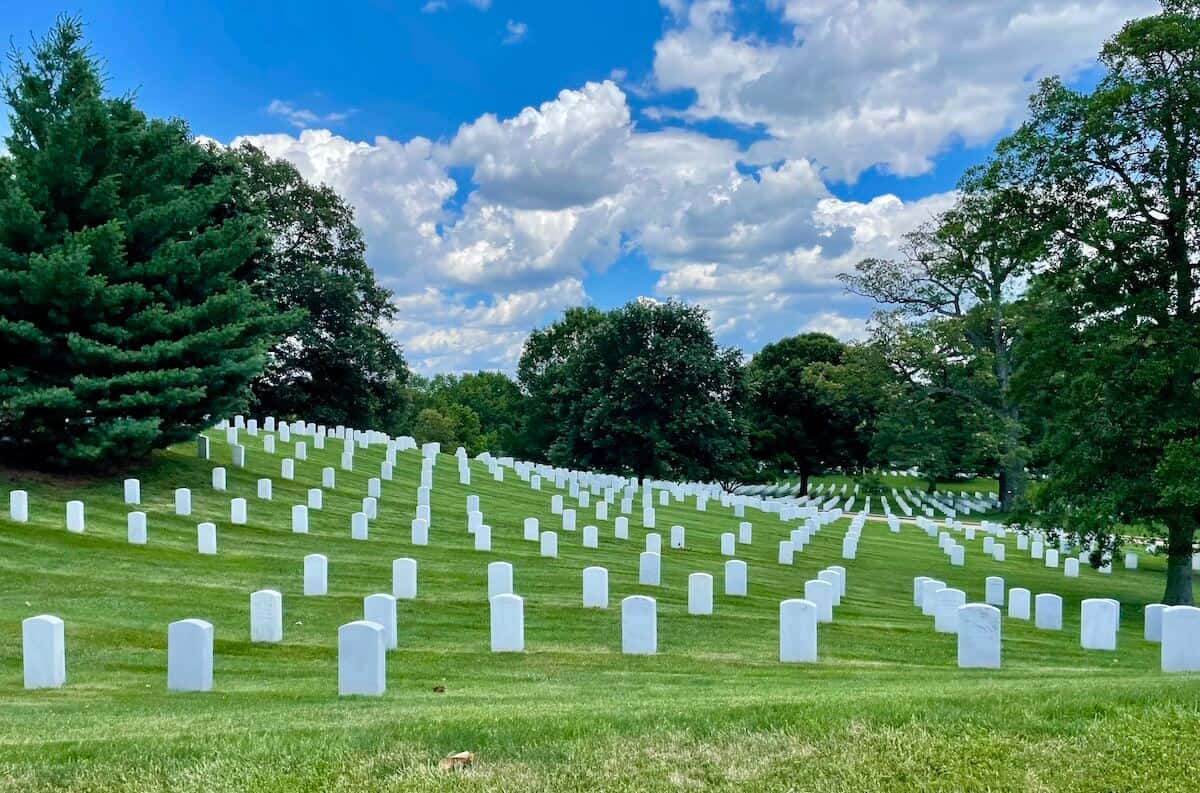
The first burial took place here in 1864, and from then it became a national cemetery. At the time, burying the war dead here was a way to make sure that service members received a proper burial even if they were far from their homes. The first Memorial Day (originally called Decoration Day) was marked at the cemetery on May 30, 1868.
Today over 400,000 veterans (and some of their dependents) are buried on the cemetery’s 639 acres. The cemetery sees up to 30 funerals a day. Because of space limitations, the cemetery added columbarium courts that are used to house the ashes of more recently deceased. Three major annual memorial services are held in the Amphitheater, near the Tomb of the Unknown Soldier; they are on Easter, Memorial Day, and Veteran’s Day. Location: Arlington, VA.
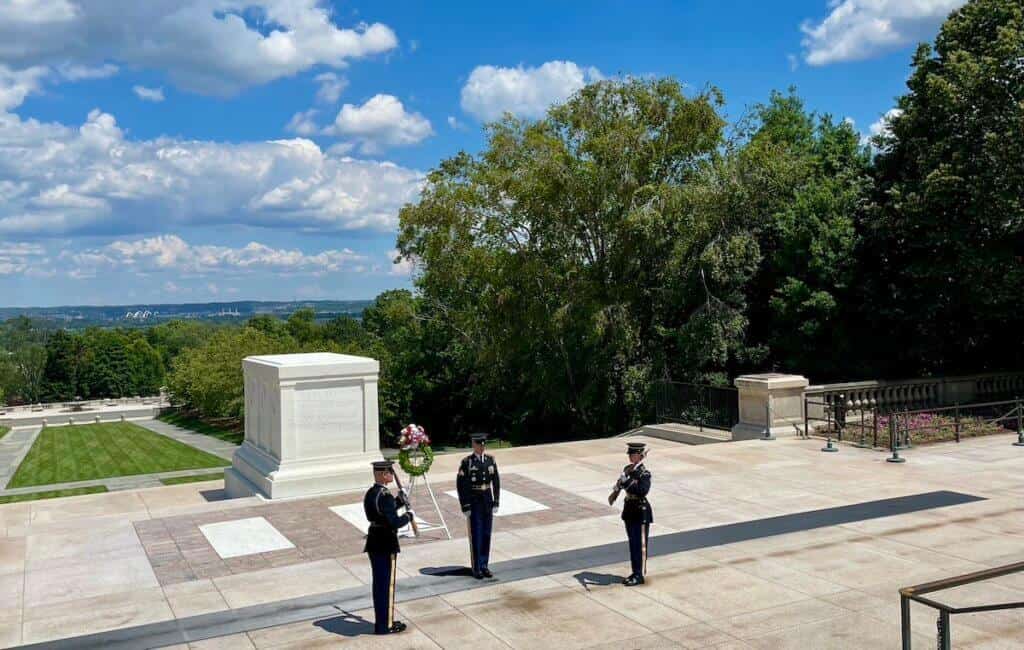
Most Visited Sites in the Cemetery
- The Tomb of the Unknown Soldier was dedicated in 1921 with the interment of an unknown service member from World War I. In later years, other unknown dead service members were added to the tomb. Visitors can view the Changing of the Guards at the Tomb of the Unknown Soldier. Depending on the season, this happens on the hour and/or half hour.
- The Eternal Flame at the grave of John F. Kennedy is the final resting place of the 35th president and his wife, Jacqueline Bouvier Kennedy. Kennedy’s brothers Robert F. Kennedy and Edward M. Kennedy are buried nearby. By the way, there’s a second American president buried in the cemetery: William H. Taft who died in 1930.
- Arlington House sits on a hilltop overlooking Washington, D.C. and boasts magnificent views of the city. Visitors can take a tour of the building itself; walk through a small museum housing information, photographs, and artifacts from some of the enslaved members of the household; or simply sit on one of the steps at the front of the house and relax while soaking in the gorgeous vista.
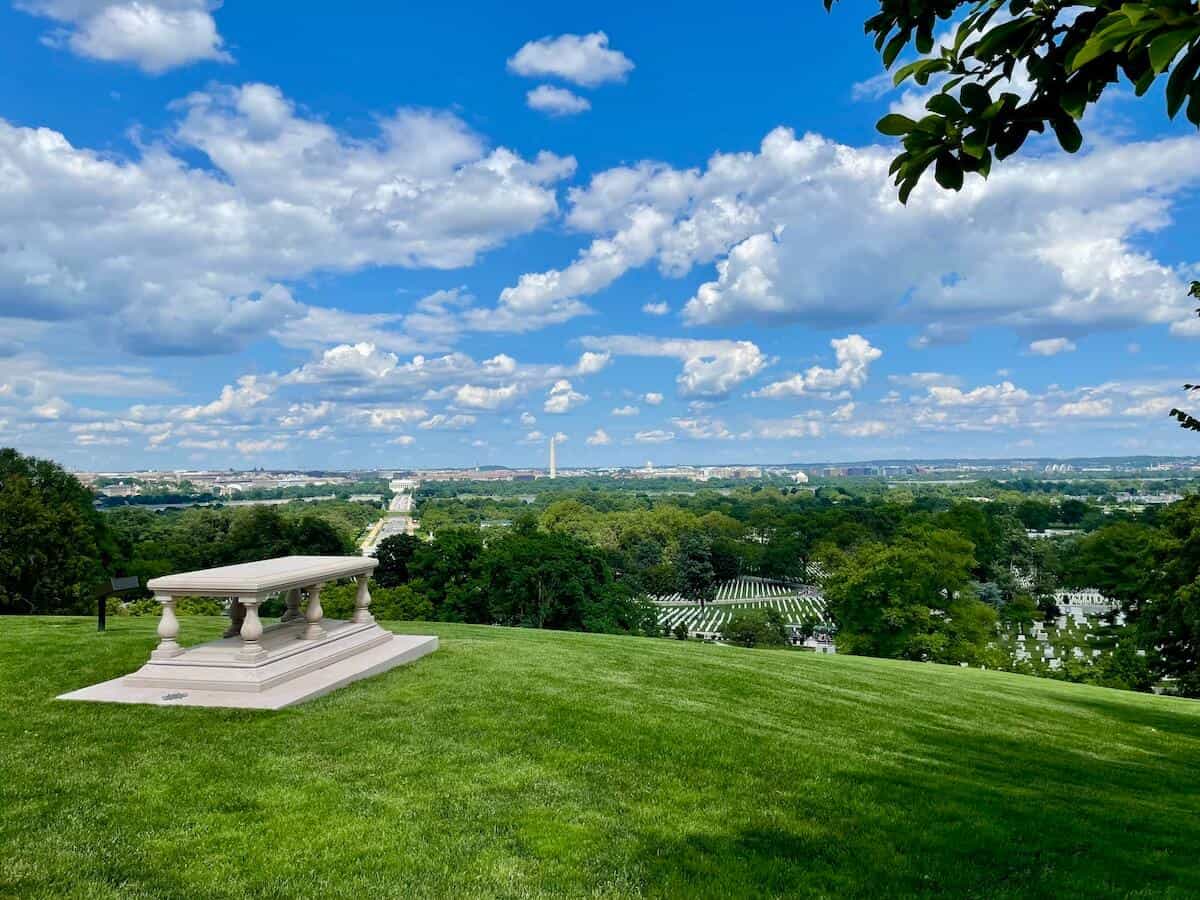
2. Constitution Gardens: Signers of the Declaration of Independence
Situated between the Vietnam Veteran’s Memorial and the World War II Memorial, Constitution Gardens is an island in a man-made lake. What makes this a place to visit, besides the tranquil setting, are the 56 stones honoring the men who signed the Declaration of Independence. Each stone has the name, occupation, and signature of that person. Location: Constitution Avenue NW.
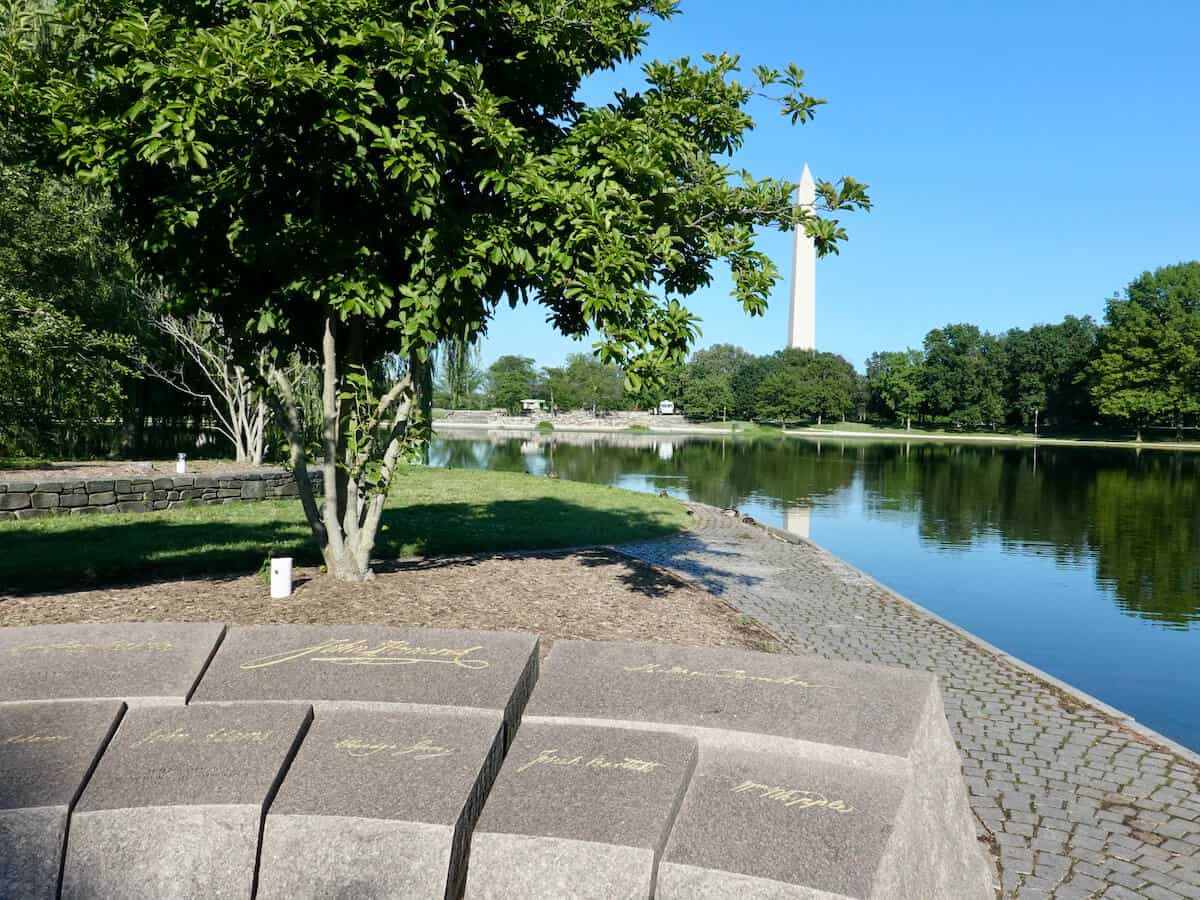
3. Dwight D. Eisenhower Memorial
The 34th American president is honored with a 4-acre memorial one street south of the National Mall. A West Point Academy graduate, Dwight D. Eisenhower served in the U.S. Army and went on to become a decorated 5-star general. He commanded the infamous D-Day attack on German-controlled France in 1944. In addition, he served as the Supreme Allied Commander of all European forces in World War II.
Seven years after the war’s end, he was elected president, serving two terms. Some of his notable accomplishments were the expansion of social programs; the creation of the interstate highway system we have today; and, of course, advocating and working for global peace.
This memorial includes depictions of Eisenhower as a young boy, a general, and a president. The stylized landscape of Pont du Hoc on the coast of Normandy, France, serves as the backdrop of the memorial; it was one of the prime landing locations of the U.S. military in the invasion. Location: 540 Independence Ave SW.

4. Franklin D. Roosevelt Memorial
This 7.5-acre memorial is dedicated to Franklin D. Roosevelt (FDR), America’s 32nd president. The memorial is really four outside rooms representing his four terms in office. There are statues of FDR as well as some representing the times of the day (like food lines during the Great Depression and FDR’s popular fireside chats).
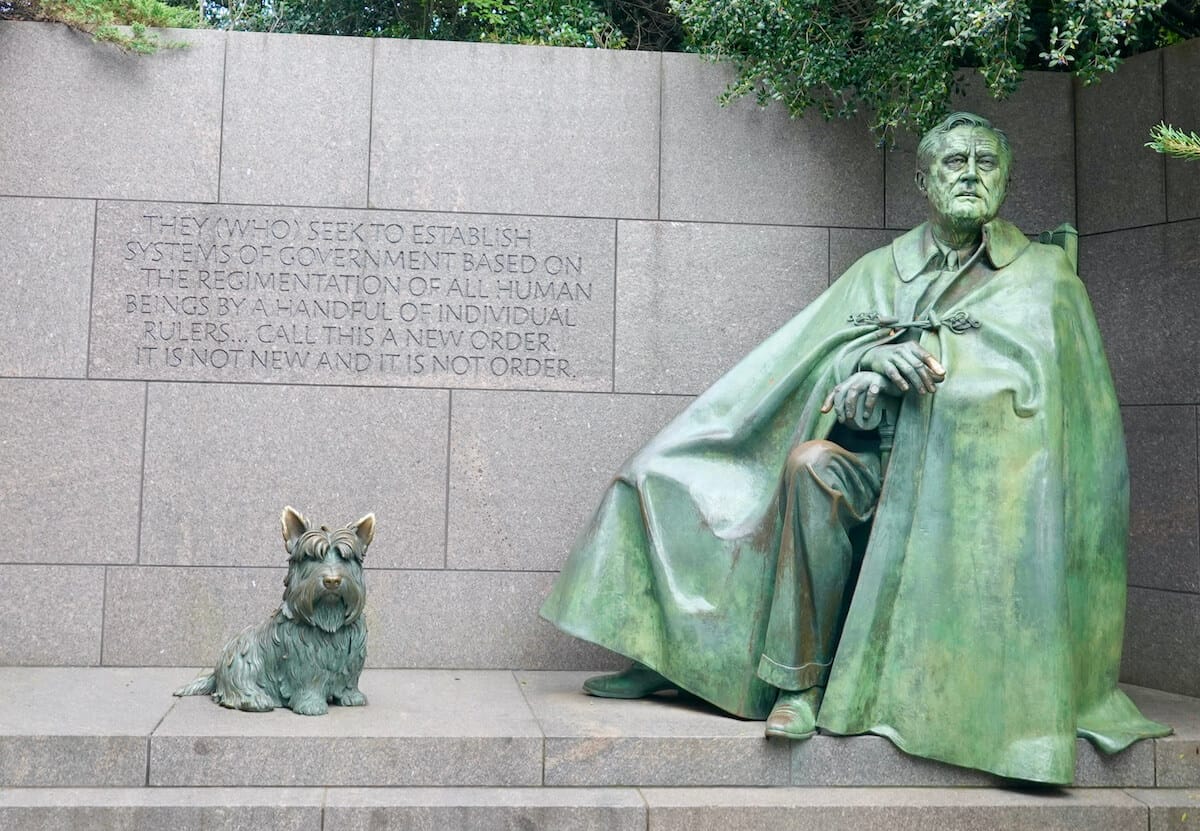
Included in the memorial is a statue of Eleanor Roosevelt, the First Lady, who stands by herself and, thus, signifies the fact that she was a strong political force in her own right.
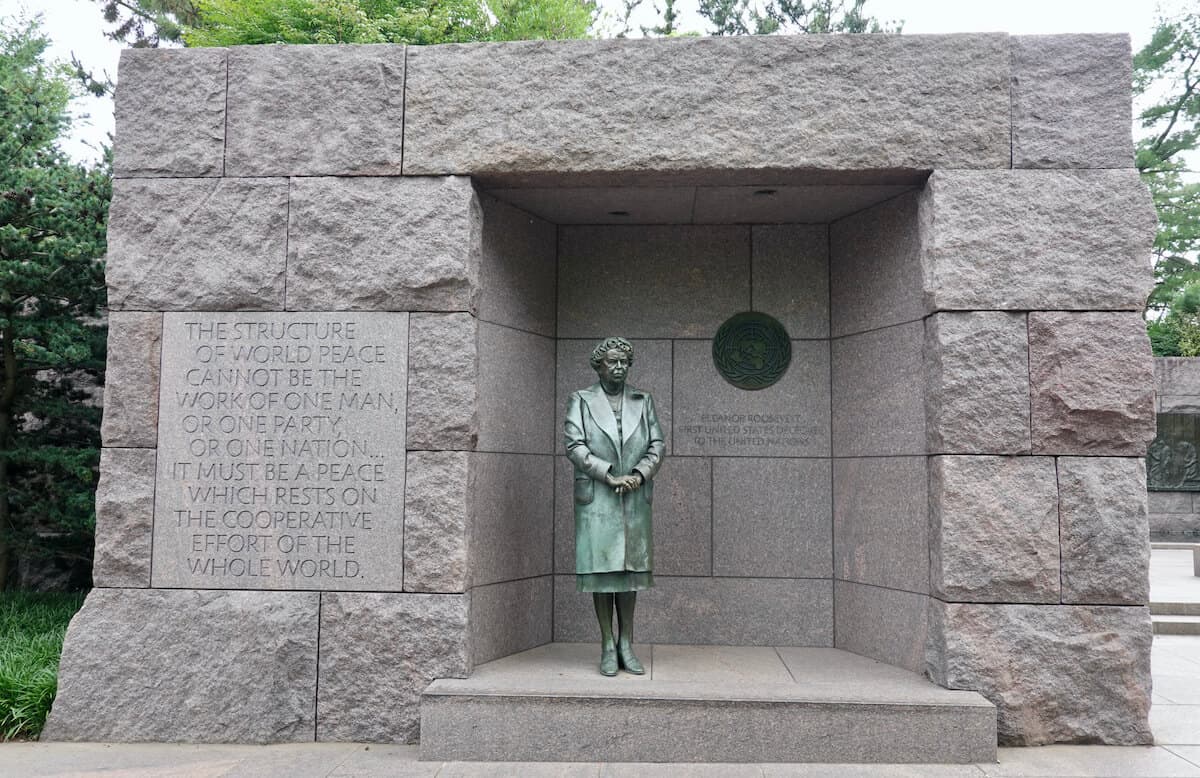
Water (and its volume of sound) is a powerful symbol in each section of the memorial. Water spills over man-made waterfalls at varying forces represent the impacts of each of FDR’s terms. They are the Great Depression, the New Deal public works projects, the battles of World War II, and FDR’s death.
Tip: Enter the memorial on the western side (as if you were walking from the Lincoln Memorial) so that you walk through it in chronological order. Location: 1850 West Basin Dr. SW.
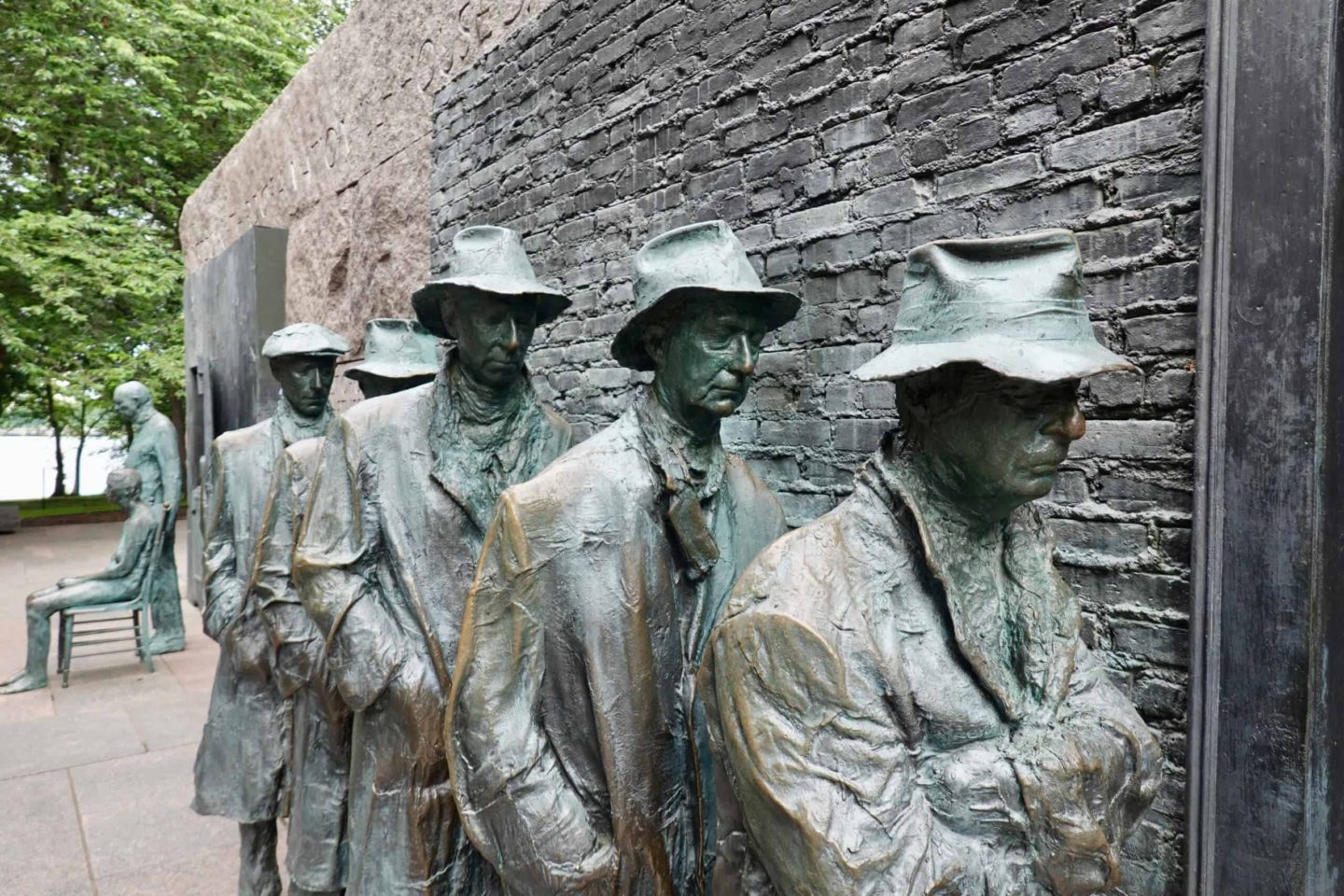
Often unknown, the original memorial to FDR sits near the corner of 9th Street NW and Pennsylvania Avenue NW. Roosevelt didn’t want a large memorial in his honor. He once remarked that if there was to be a memorial, it shouldn’t be any larger than his desk. Well, that’s precisely what this rectangular stone is — the size of a large desk.
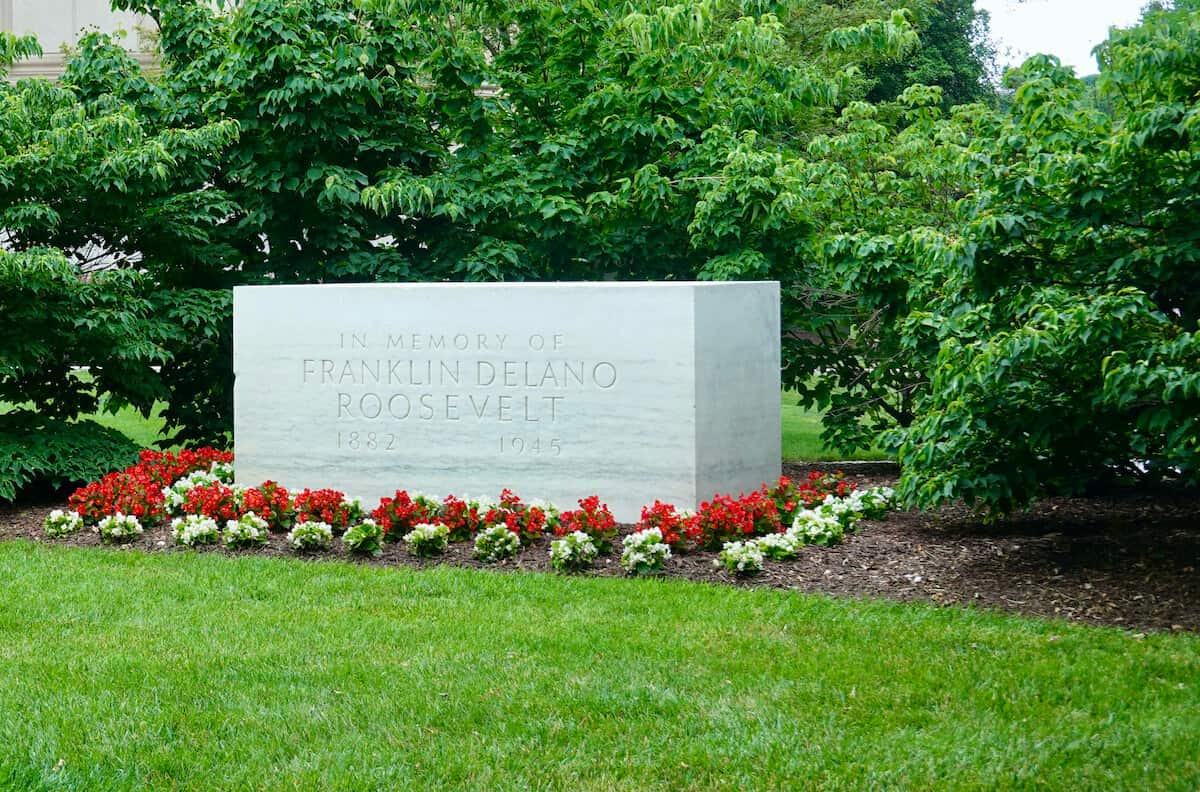
5. George Mason Memorial
There’s one memorial that’s often overlooked on tours of D.C. monuments. The George Mason Memorial, located just beyond the Lincoln Memorial, is a peaceful park-like area that honors another Founding Father. Mason wrote Virginia’s Declaration of Rights and helped to inspire the U.S. Bill of Rights. Take a few moments to enjoy this relaxing area with a fountain. Location: 24 East Basin Dr. SW.
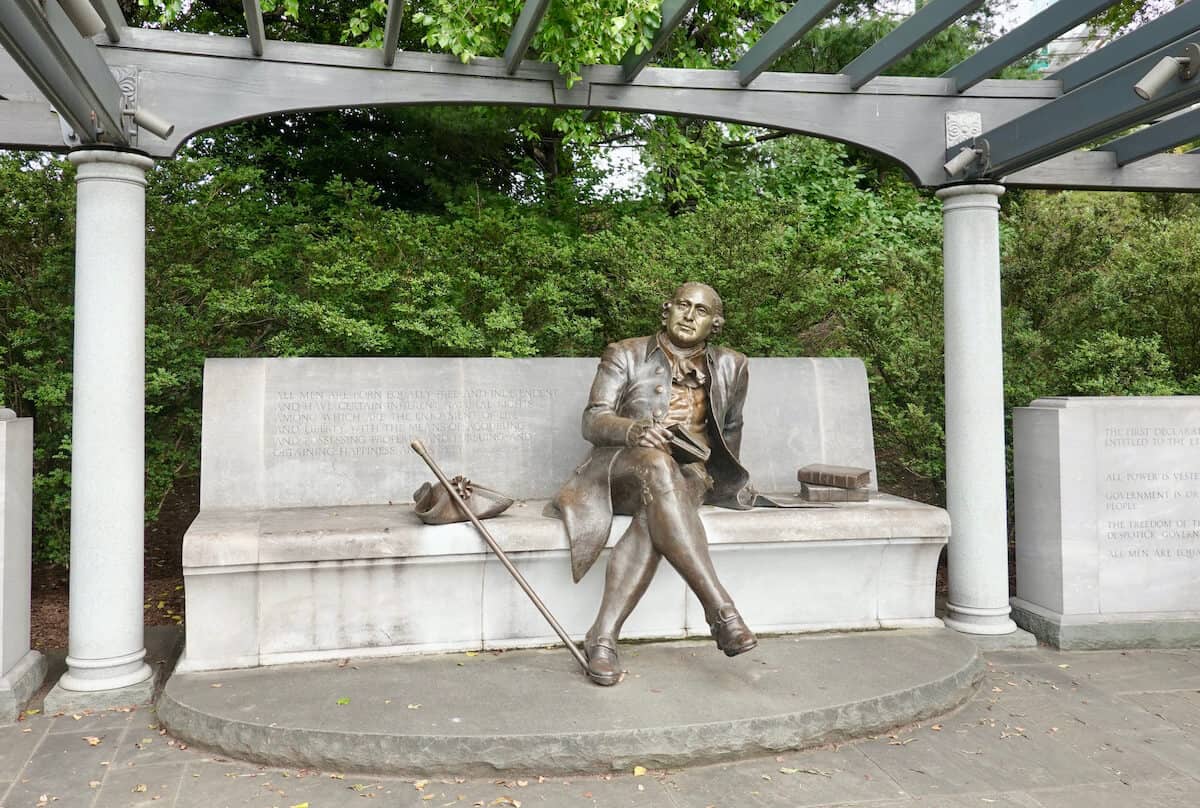
6. Grant Memorial
Standing on the western side of the U.S. Capitol, this Civil War monument honors the commanding general of the Union Army — who later became the country’s 18th president. Two large tableaus, depicting the strength of the Union forces, flank the statue of Grant on horseback. Looking up at Grant, you’ll see the U.S. Capitol behind him; turn around, and you’ll have a sweeping view of the National Mall and the Washington Monument in the distance. Location: on the western side of the U.S. Capitol.
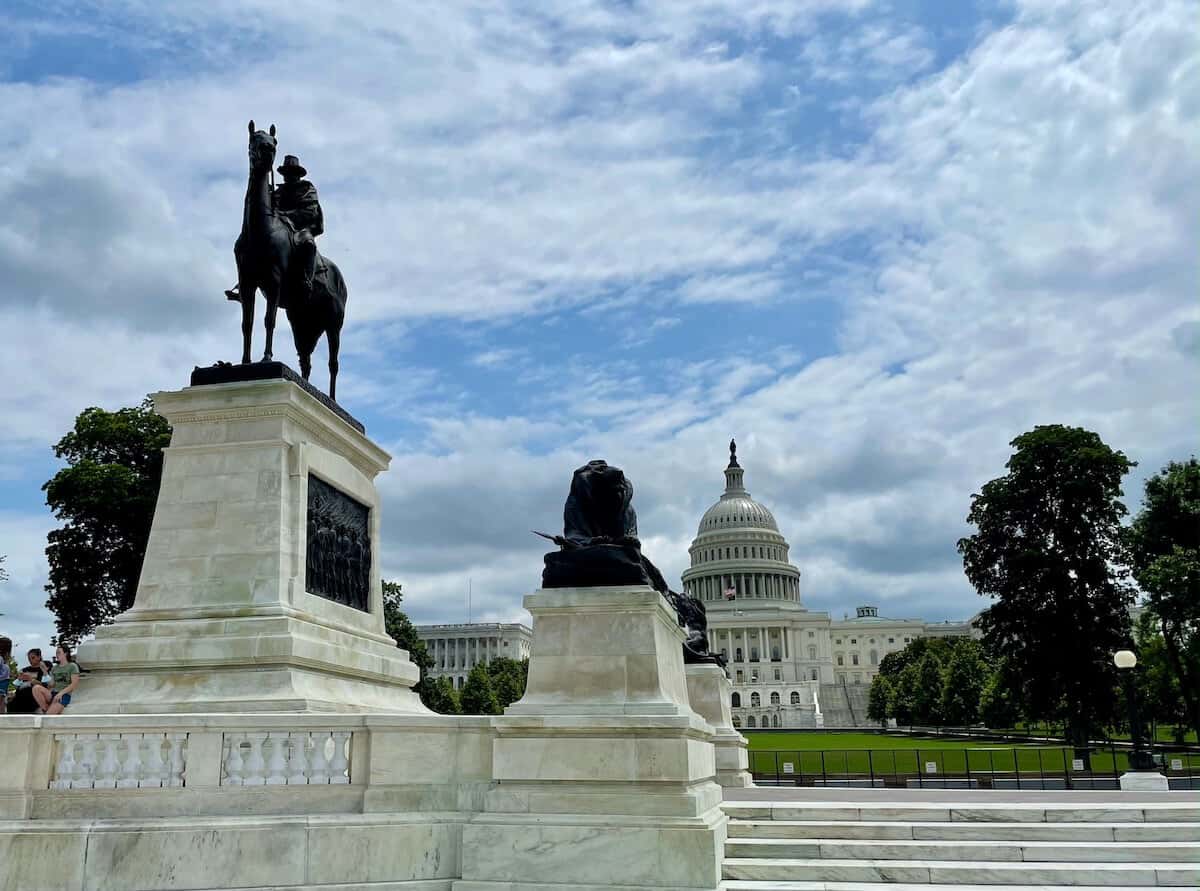
7. Jefferson Memorial
Thomas Jefferson, one of the country’s Founding Fathers, was its first Secretary of State and its third president. The 19-foot tall figure of Jefferson inside his domed memorial faces the White House. In fact, the Jefferson Memorial is directly in line with the White House to its north. Excerpts from his writings, including the Declaration of Independence, which he authored, are engraved on the walls behind him.
The Pantheon in Rome inspired the memorial’s design. A similar design can be found in the rotunda at the University of Virginia, which Jefferson designed. Many visitors enjoy a visit here — especially when the cherry trees, lining the Tidal Basin, bloom each spring. Location: 16 E Basin Dr. SW.
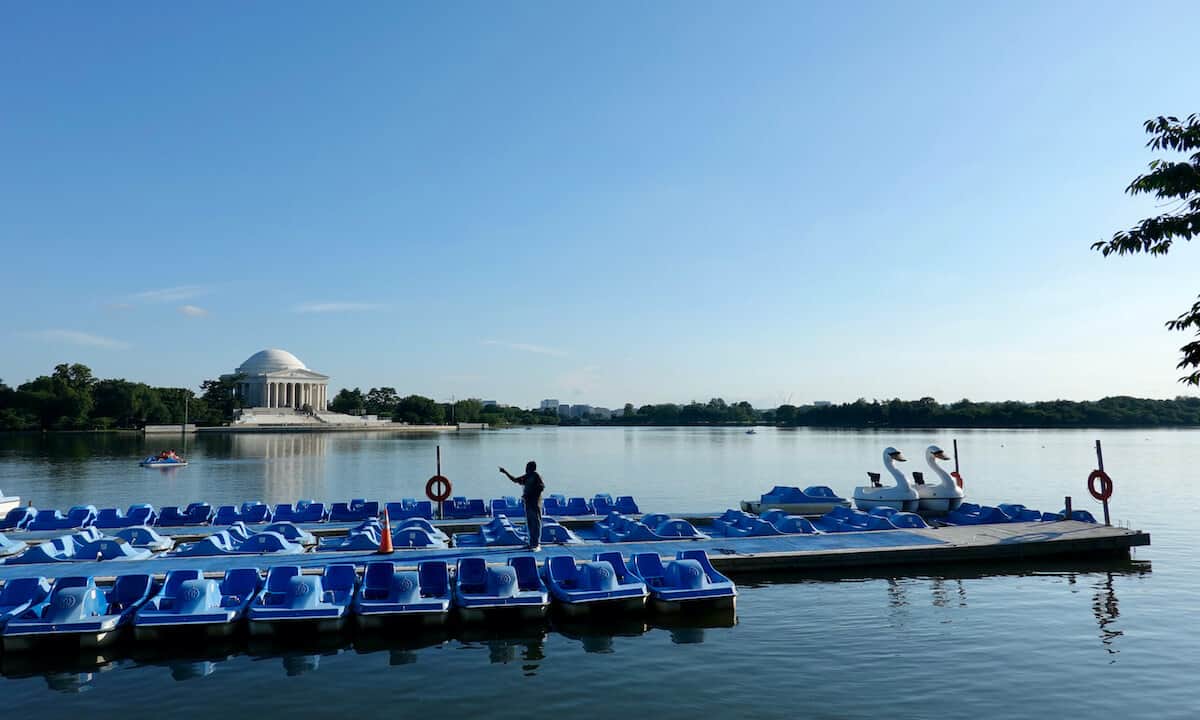
8. Korean War Veterans Memorial
A platoon of U.S. soldiers, 19 statues representing four branches of service, are the main visual remembrance and memorial to those who fought in the Korean War. The nearby Mural Wall has more than 2,500 photographic images of servicepeople who actually served in the war. The newest feature of this memorial is the Memorial Wall. It lists the tens of thousands of Americans (and U.S. Army Korean forces) who died in the war. Location: off Independence Avenue, southeast of the Lincoln Memorial.
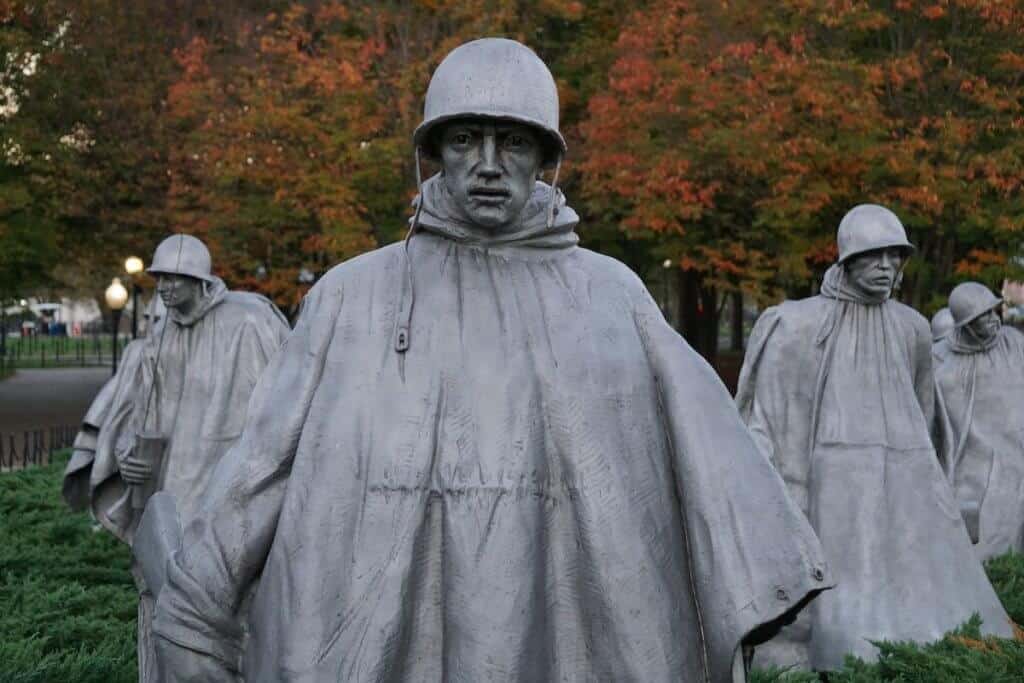
9. Lincoln Memorial
One of the most iconic structures in the capital, the Lincoln Memorial is located on the western end of the National Mall. In fact, it’s right in line, west to east, with the World War II Memorial, the Washington Memorial, and the U.S. Capitol. The massive marble statue of the 16th president sits high above those visiting. Lincoln’s right hand is relaxed while the other is clenched, perhaps signifying the weight this man carried during a tumultuous time of his presidency, the Civil War. On the surrounding walls inside are excerpts of Lincoln’s speeches including his second inaugural address and his Gettysburg Address.
The building itself drew inspiration from the Parthenon in Athens. Its 36 exterior columns mirror the number of states in the U.S. at the time. The 48 contiguous states, along with their dates of admission to the U.S. are inscribed on the colonnade. Hawaii and Alaska, territories that became states well after this building was complete, are listed on a plaque by the steps.
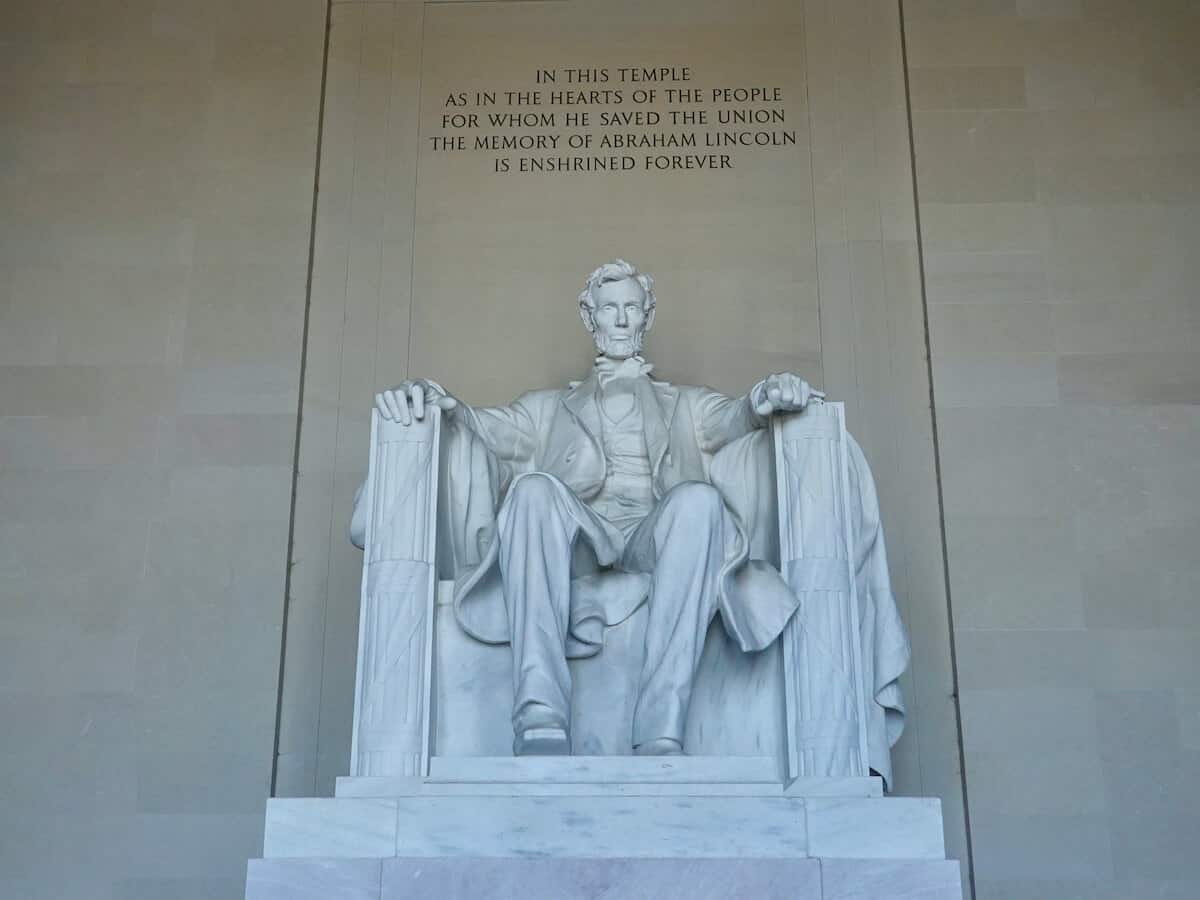
A Historical Setting
This memorial has been the setting of several historical events relating to civil rights, a reminder of Lincoln’s Emancipation Proclamation that freed enslaved people in the U.S. One is the 1939 performance of African-American singer Marion Anderson who was not allowed to perform at Constitution Hall; when hearing of the snub, Eleanor Roosevelt helped to make the performance happen — at the Lincoln Memorial. Also, this was the site of Martin Luther King, Jr’s famous “I Have a Dream” speech in 1963. In fact, part of that speech is inscribed on a landing on the front steps — where he stood while speaking that day.
10. Marine Corps Memorial (Iwo Jima)
Paying homage to all Marines, this 78-foot tall memorial used the classic Pulitzer Prize-winning photograph taken by Joe Rosenthal as its model. It was in 1945 that Marines raised the American flag on Iwo Jima after gaining military control of this small island, off the Japanese coast, in World War II. The memorial is located just outside the gates of Arlington National Cemetery. To be fair, there are monuments and memorials to other military branches, but this speaks to so many because of its connection to an instantly recognizable World War II image. Location: U.S. Marine Memorial Circle, just outside Arlington National Cemetery.
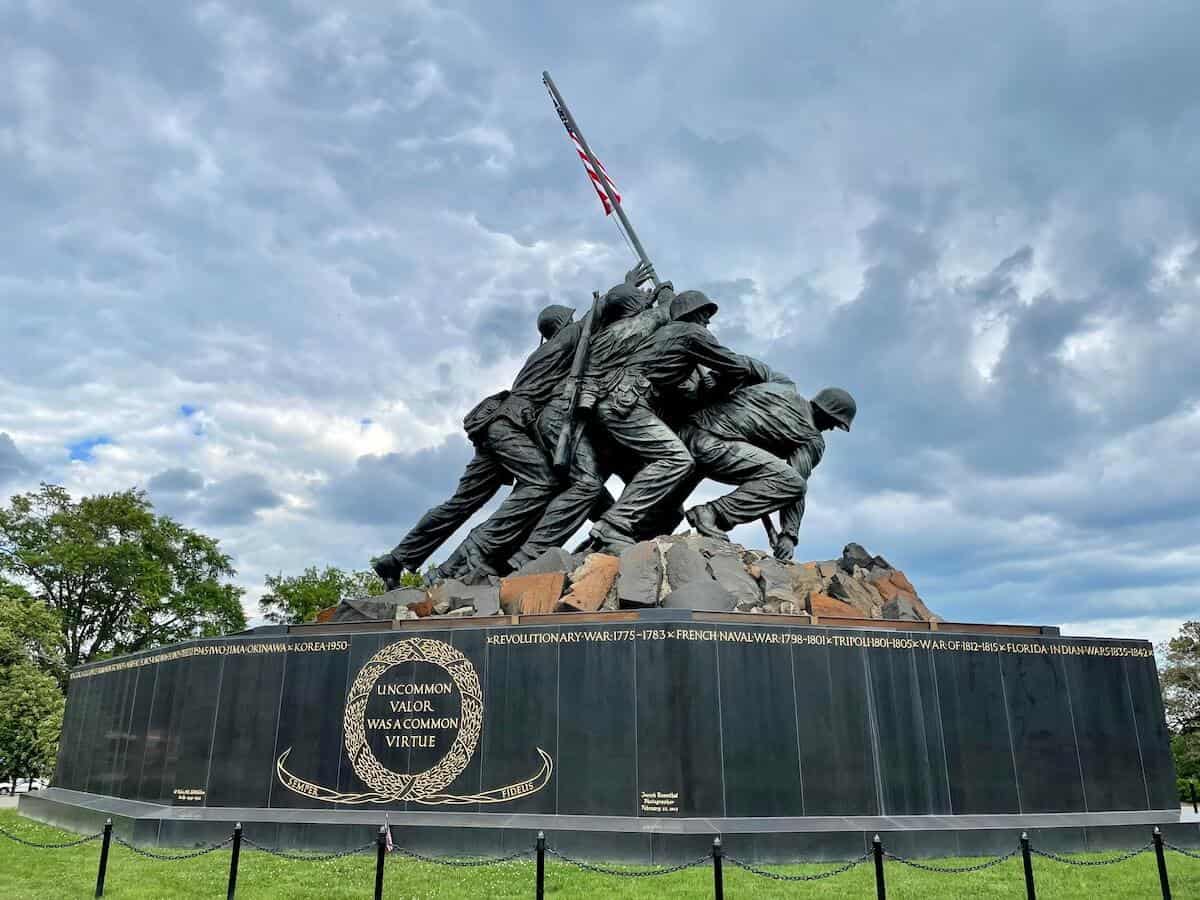
11. Martin Luther King, Jr. Memorial
Dedicated in 2011, the Martin Luther King, Jr. Memorial serves up powerful symbolism in its design and placement.
Regarding the design, visitors, who approach from the back, walk through a small courtyard. That courtyard represents the “Land of Lack of Opportunity” that disadvantaged some Americans due to the color of their skin. That courtyard narrows into an opening between the “Mountain of Despair.” A likeness of the civil rights leader fronting the “Stone of Hope” is visually pushed forward from the “Mountain of Despair.” In fact, a phrase he used in his 1968 “I Have a Dream Speech” — “Out of the mountain of despair, a stone of hope” — is etched in the memorial. Notice the striations on the side of the “Stone of Hope” that are meant to bring the scars of racism and injustice to mind.
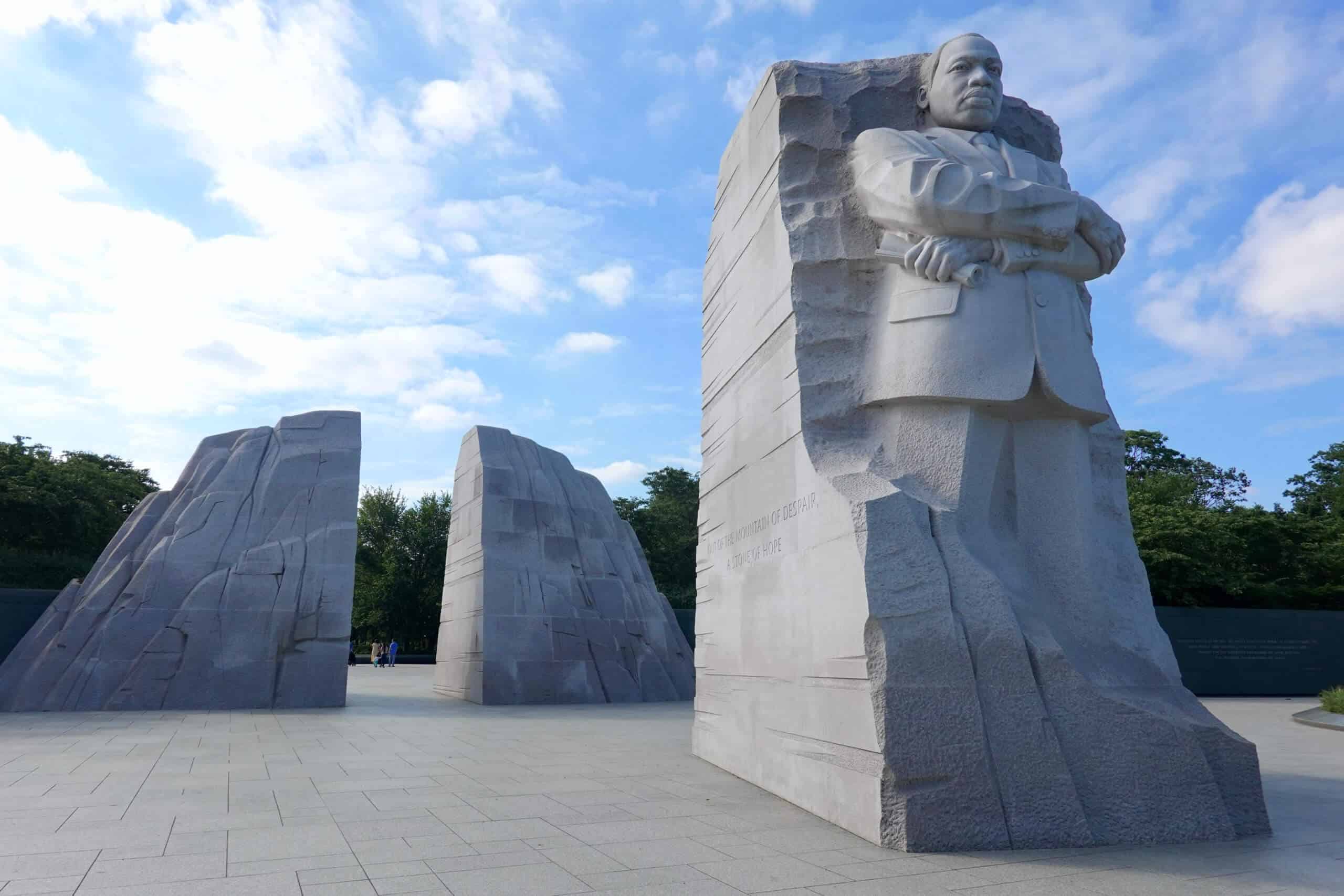
As for the location of this memorial, it is in a 45-degree line from the Lincoln Memorial and faces the Jefferson Memorial. How fitting as that placement represents three elements of human rights: Jefferson’s writing of “all men being created equal” in the Declaration of Independence, the equality that Martin Luther King, Jr. fought for; the Emancipation Proclamation signed by President Abraham Lincoln; and Martin Luther King, Jr’s own quest for equality and civil rights for all Americans, regardless of their differences.
As mentioned, excerpts from King’s “I Have a Dream” speech are etched into a landing at the Lincoln Memorial where King stood while delivering that address to more than 250,000 people on the National Mall that day. Location: On the northwest bank of the Tidal Basin, between the Jefferson Memorial and Lincoln Memorial
12. Theodore Roosevelt Memorial
Off the beaten path, the Theodore Roosevelt Memorial is actually on Theodore Roosevelt Island in the Potomac River. The nation’s 26th president, Roosevelt championed the preservation of land, natural resources, and wildlife (among other accomplishments); he also expanded the country’s national parks and national forests. How fitting that the monument to him sits on an undeveloped island.
The statue of Roosevelt stands in a clearing on the island; trees and stone pillars etched with some of his quotes form its backdrop. In addition to the monument to Theodore Roosevelt, there are several walking trails around and in the interior of the small island. It’s a short 1.5-mile drive away from the other prominent memorials of past presidents. Access the island from George Washington Memorial Parkway. Location: Theodore Roosevelt Island, reached by a footbridge from a parking lot.
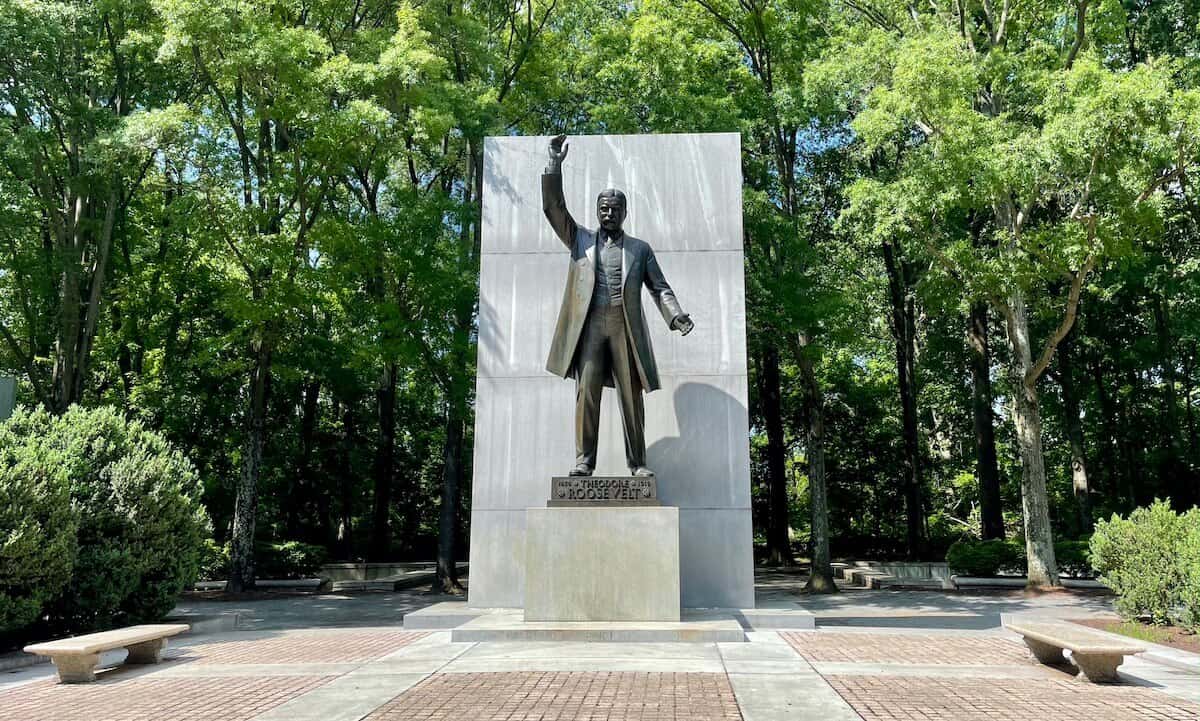
13. Vietnam Veterans Memorial
The Vietnam Veterans Memorial includes three main components.
- The Wall lists the names of over 58,000 service members who were killed or missing in action in the war that spanned from 1959-1975. (The designer was Yale University architect student Maya Lin who, at the age of 22, won the design competition for the memorial.) A name with a cross indicates a person who was missing in action. A name with a cross and diamond represents a person who was thought to be missing in action at the time the memorial was built but was later found to have been killed.
- The Three Soldiers statue represents those who fought in the war and includes servicemen of different ethnicities. They are facing The Wall, with the names of their fallen comrades. A flagpole near this statue flies the Stars and Stripes and recognizes each military branch at its base.
- The Vietnam Veterans Women’s Memorial honors the more than 250,000 female nurses and civilians who helped in the war effort. This memorial depicts nurses aiding a wounded soldier.
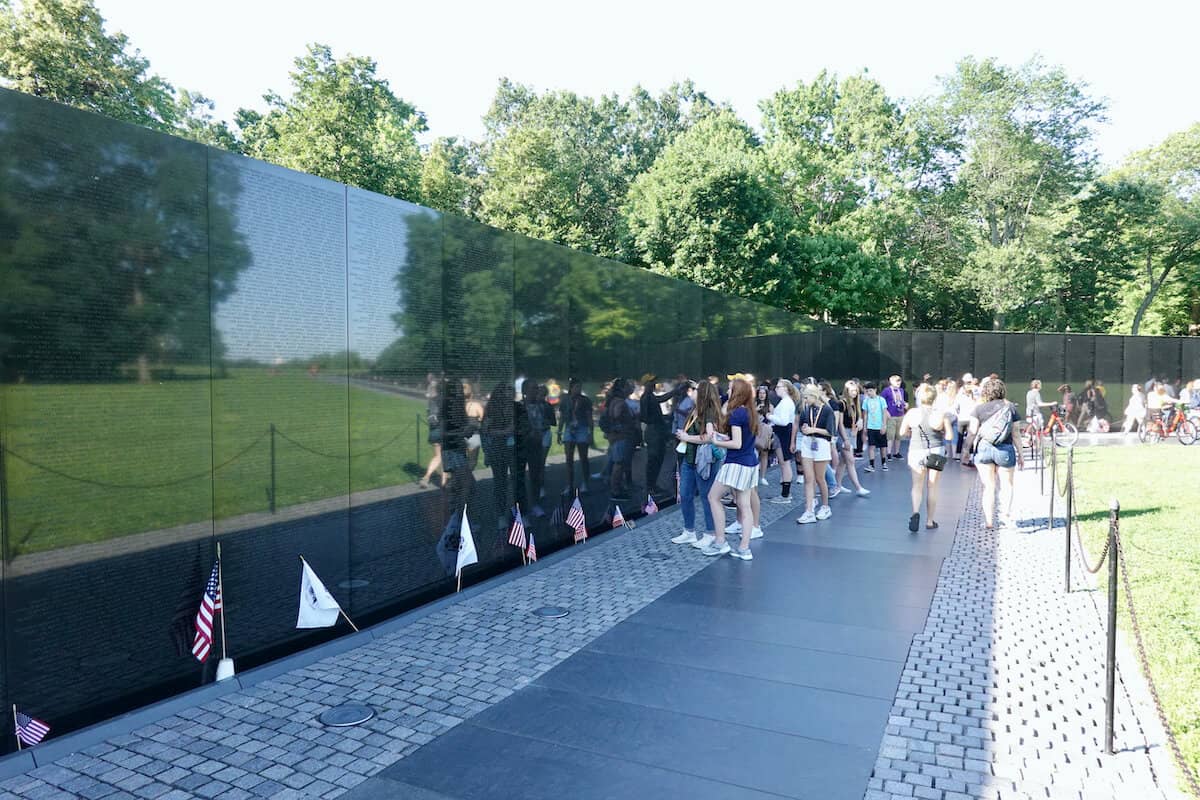
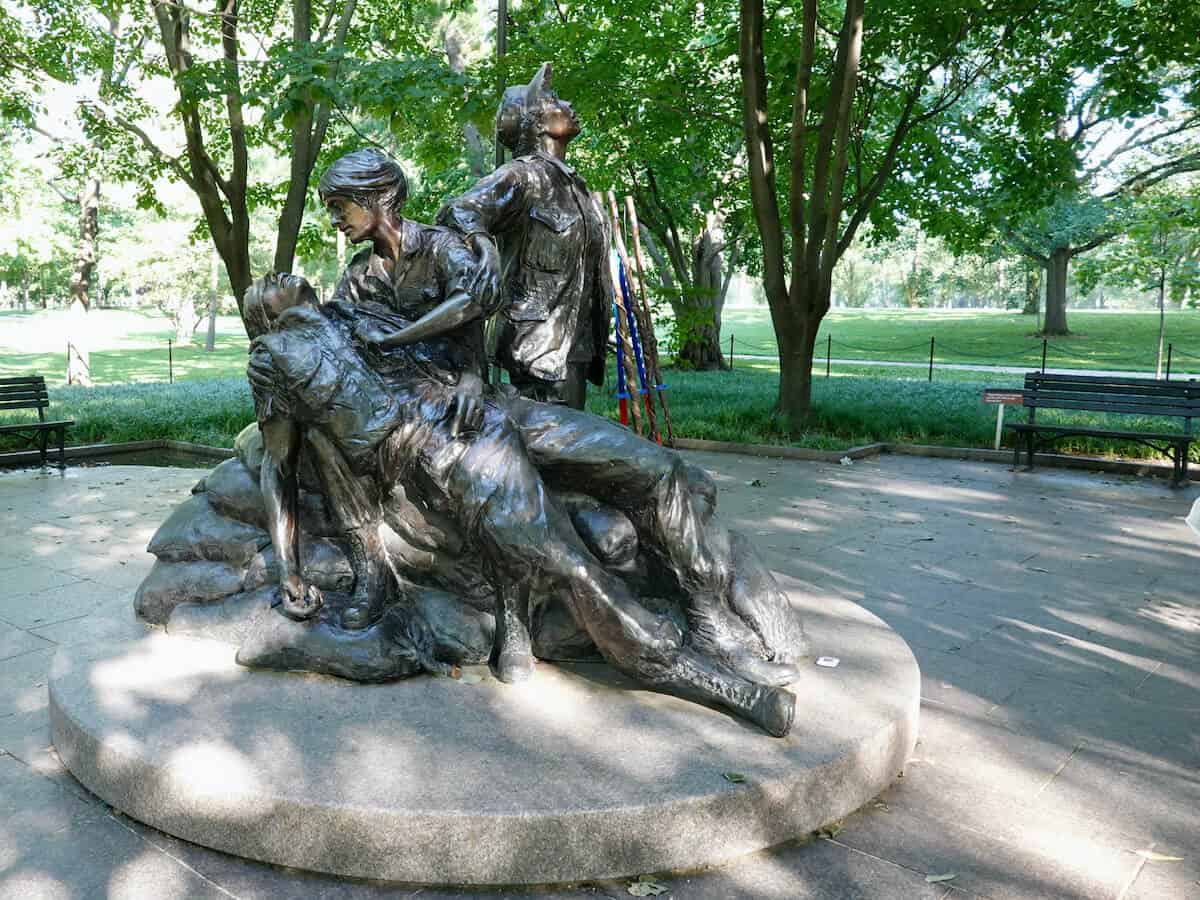
14. Washington Monument
A monument known the world over, the Washington Monument is an obelisk and stands 555 feet tall. Construction began in the 1840s and was paused during the Civil War (and the area around the structure was actually used to house cattle belonging to the federal government) when funding for it waned. Work continued in the 1870s and the monument was finally dedicated in 1885. Reconstruction work has been performed periodically over the years including after a 2011 earthquake. More recently, the elevator lifting visitors to the viewing area at the apex was modernized in 2019. Check online for days and hours of Washington Monument tours.
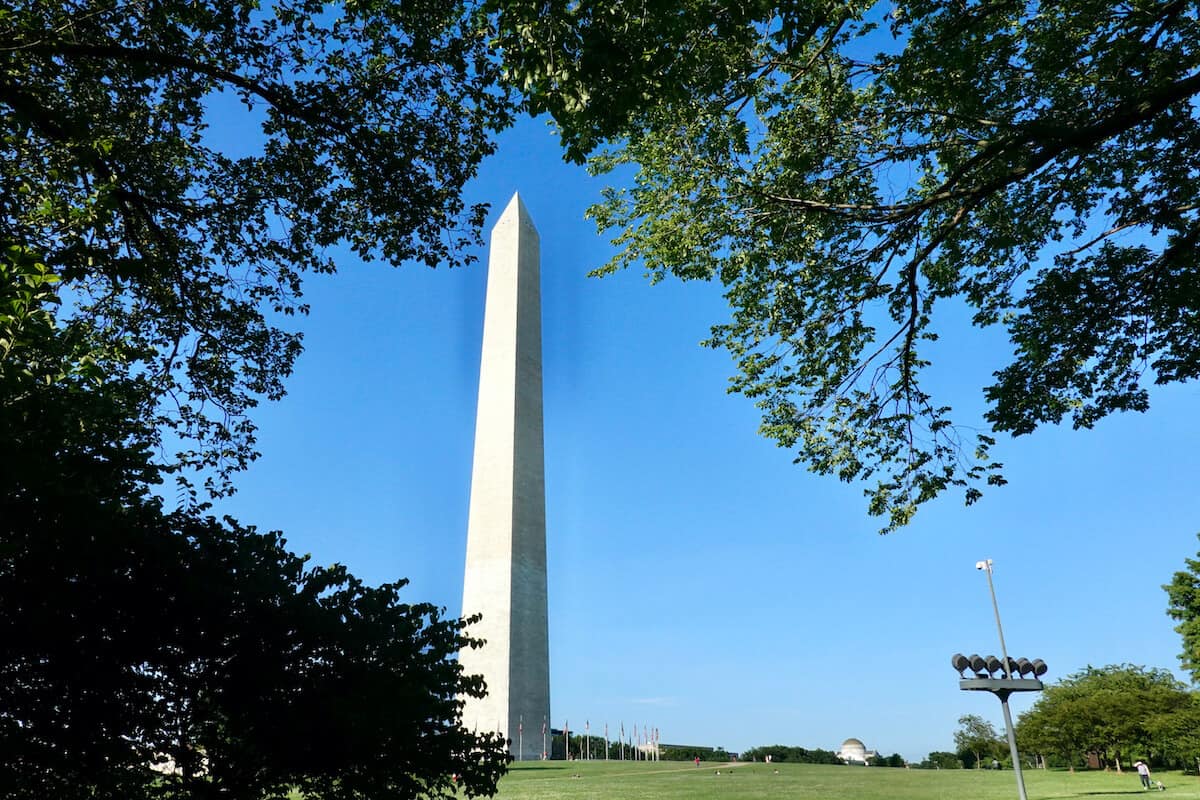
Many people notice the difference in the color of the facade’s stone. That’s due to the fact that construction stopped for about 20 years in the mid-19th century; when work resumed, the design and construction team were unable to match the lighter granite used up to that point.
15. World War I Memorial
Unveiled in 2021, the World War I memorial is actually an expansion of the Pershing Plaza commemorating General John Pershing, who commanded forces in Europe during World War I. The statue remains, and the area was refurbished and some additions made to honor the more than 2 million service members — over 117,000 of whom were killed — who fought in the war. A 60-foot-long sculpture, titled A Soldier’s Journey, is to be installed in 2024. (Before that time, a canvas representation is hung in its place.) Informational signs and maps of the war’s military conflicts provide context to visitors. Location: 14th Street and Pennsylvania Avenue NW.
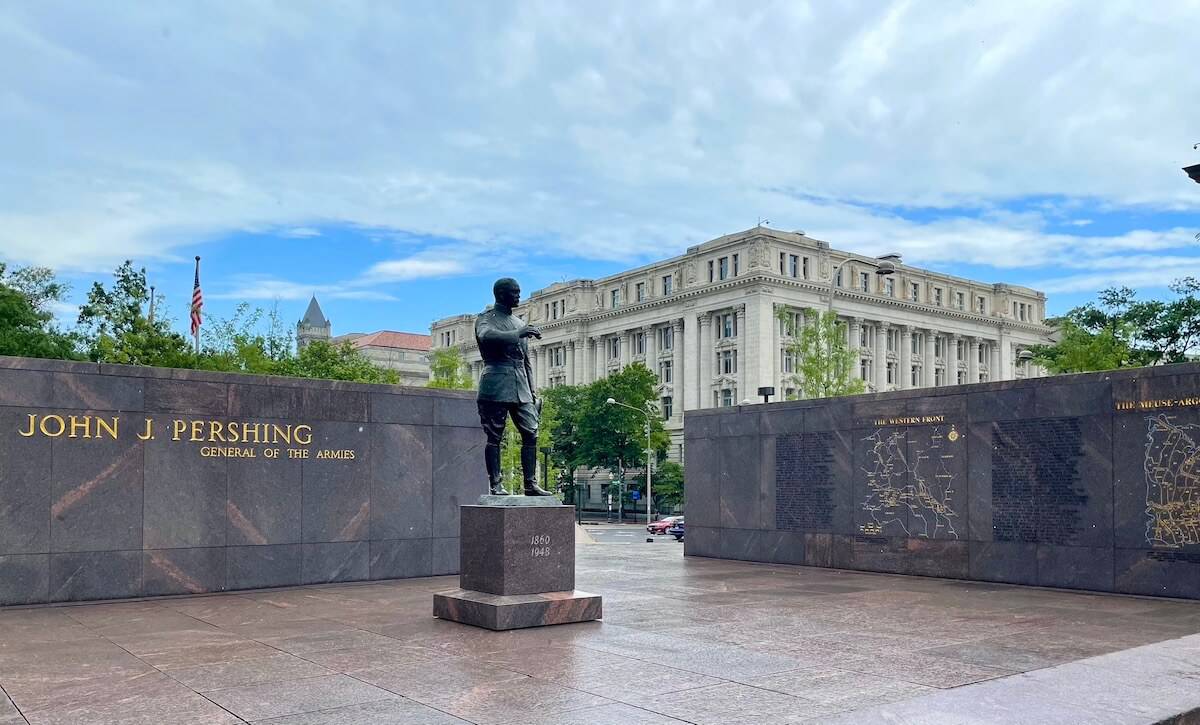
16. World War II Memorial
The large World War II Memorial commemorates all who fought (including those who died) in World War II and those back home supporting the war effort. The huge granite columns forming a circle around a fountain represent the states and territories of the United States at the time of the war. To one side is a wall holding 4,048 gold stars that represent the over 400,000 service members who died in the war; that works out to 100 lives for each gold star. Powerful. Location: on the National Mall between the Lincoln Memorial and the Washington Memorial.
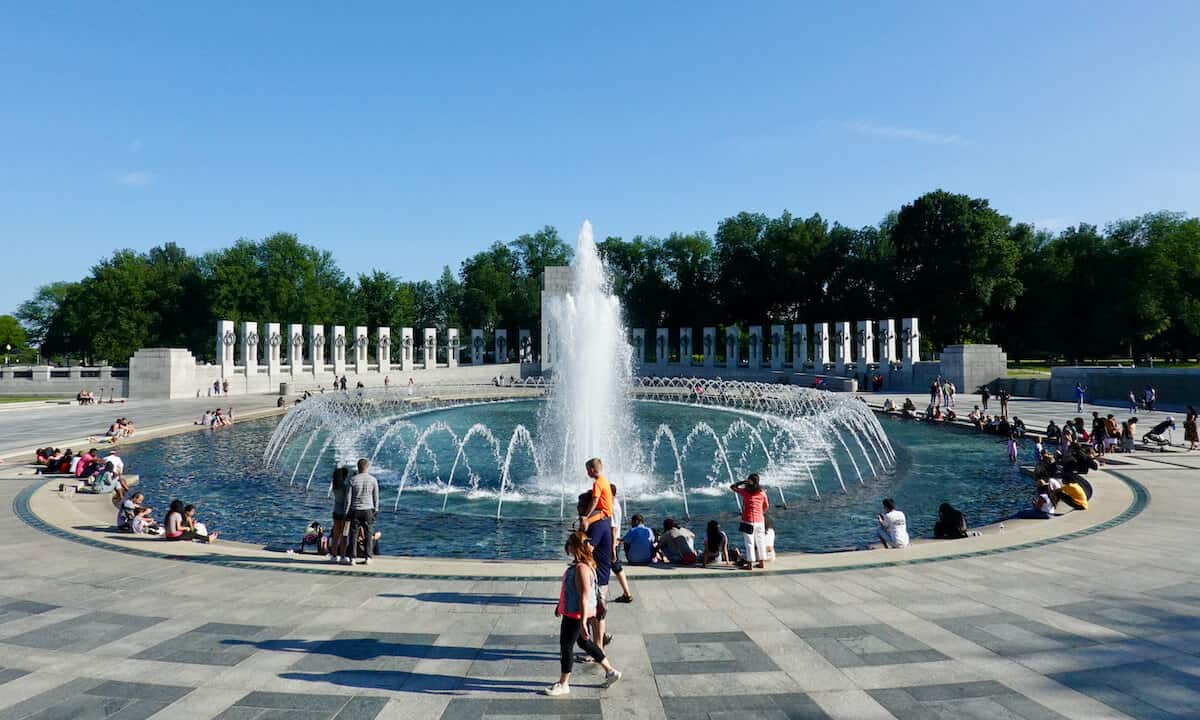
“Kilroy was here.” Remember Kilroy? He was the graffiti-like symbol (what we’d call a meme today) that was said to be drawn by U.S. servicemen where they were stationed — or visited — during the war. Eagle-eyed visitors can find a depiction of Kilroy on the outside of the memorial. (Hint: Look behind the Pennsylvania column.)
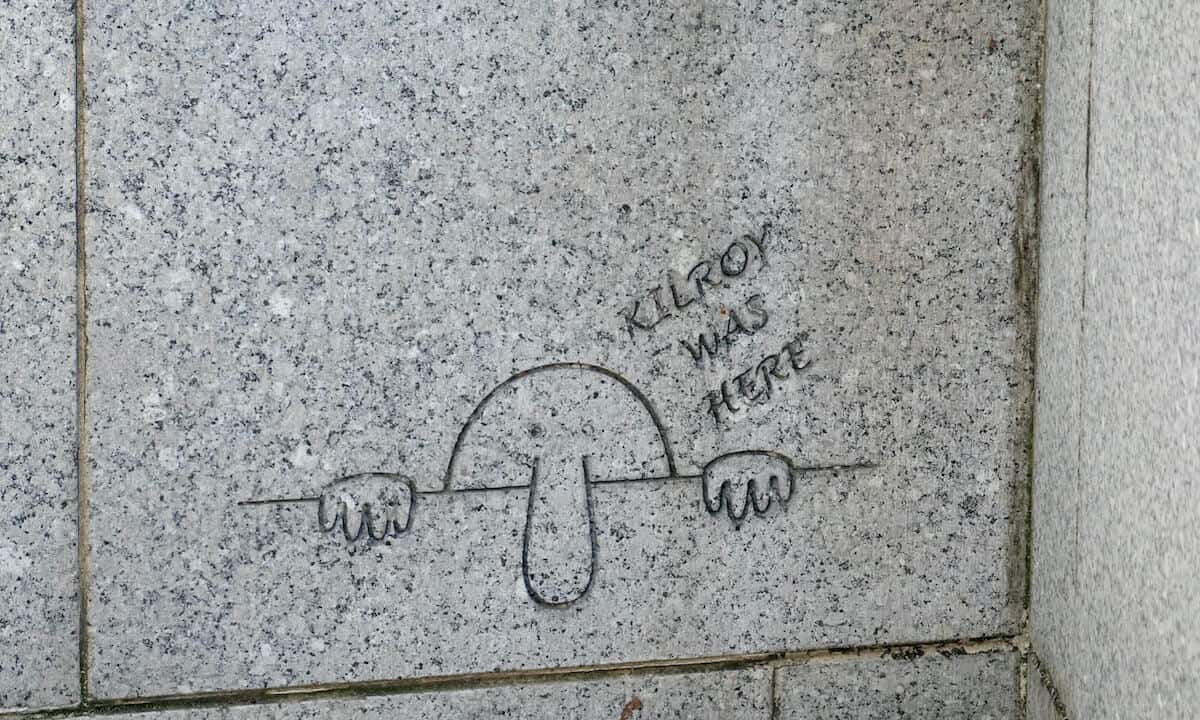
What’s the best way to visit the memorials and monuments?
If you don’t have a car when setting out to see the memorials, you can use the Metro to plan your beginning and ending points. For instance, you could take the Metro to a station close to the memorial you want to see first. Then, after you finish your tour of the monuments and are ready to leave, pick a Metro station close to your ending point.
Three common ways to visit the memorials are by:
- walking. This method may end up taking the longest amount of time, but it was the perfect way for us to really see what we came to see. (We took along a light picnic in a backpack and found a shady spot to enjoy some refreshments along the way. There were food trucks and people selling cold water at several of the monuments, so we wouldn’t have starved if we hadn’t brought food with us.)
- biking. Bring your own or use the rental bikes operated by Capital Bikeshare that are located all around the city and by many memorials.
- taking a bus or trolley tour. However, it’s only when you’re walking or biking that you can get up close to all the monuments and have time for taking pictures and reflecting on what the memorials represent.
How We Did It
When we visited, we stayed in a hotel on the District Wharf, in the southwest area of the city. Using the Wharf as our home base, we walked to the monuments and everything else we wanted to see including the National Mall and some museums. (By the way, staying on the Wharf was a great experience as there are plenty of restaurants and entertainment there.)
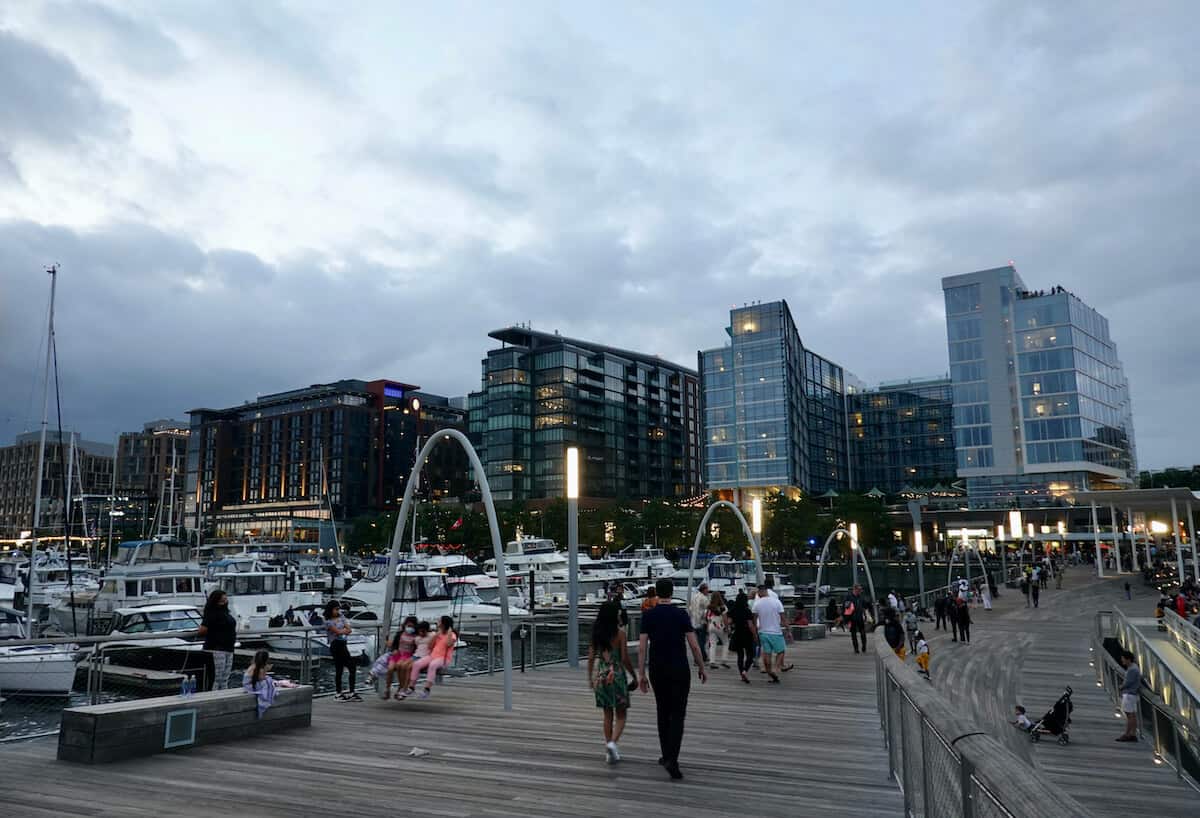
One afternoon, my husband and I walked in a loop beginning at the Jefferson Memorial and visited the George Mason Memorial, the Franklin D. Roosevelt (FDR) Memorial, the Martin Luther King, Jr (MLK) Memorial, the Korean War Veterans Memorial, the Lincoln Memorial, Constitution Gardens and concluded with the World War II Memorial. The walk itself would take an hour by itself, but factor in extra time so you can really enjoy each space.
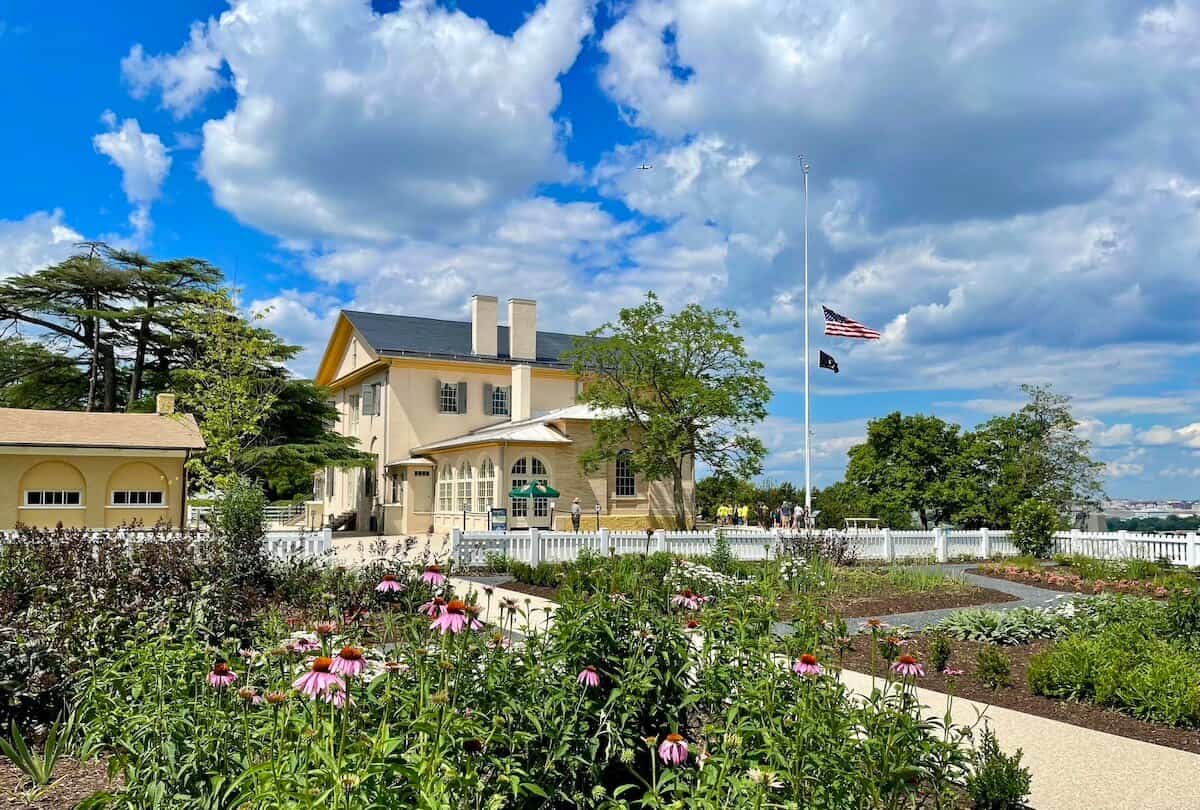
The next morning, while walking around the National Mall (and visiting museums), we viewed the Eisenhower Memorial, the Ulysses S. Grant Memorial (in front of the Capitol), the Franklin D. Roosevelt stone block (the original memorial to him), the World War I Memorial (previously known as Pershing Park), and the Washington Monument. On other parts of our visit, we went to Arlington National Cemetery and hiked around Theodore Roosevelt Island, each a short drive away.
Map of D.C. Monuments and Memorials
The National Park Service (NPS) has a handy map of Washington, D.C. showing the monuments, memorials, and other important buildings. You can also download the NPS app using the link with their map.
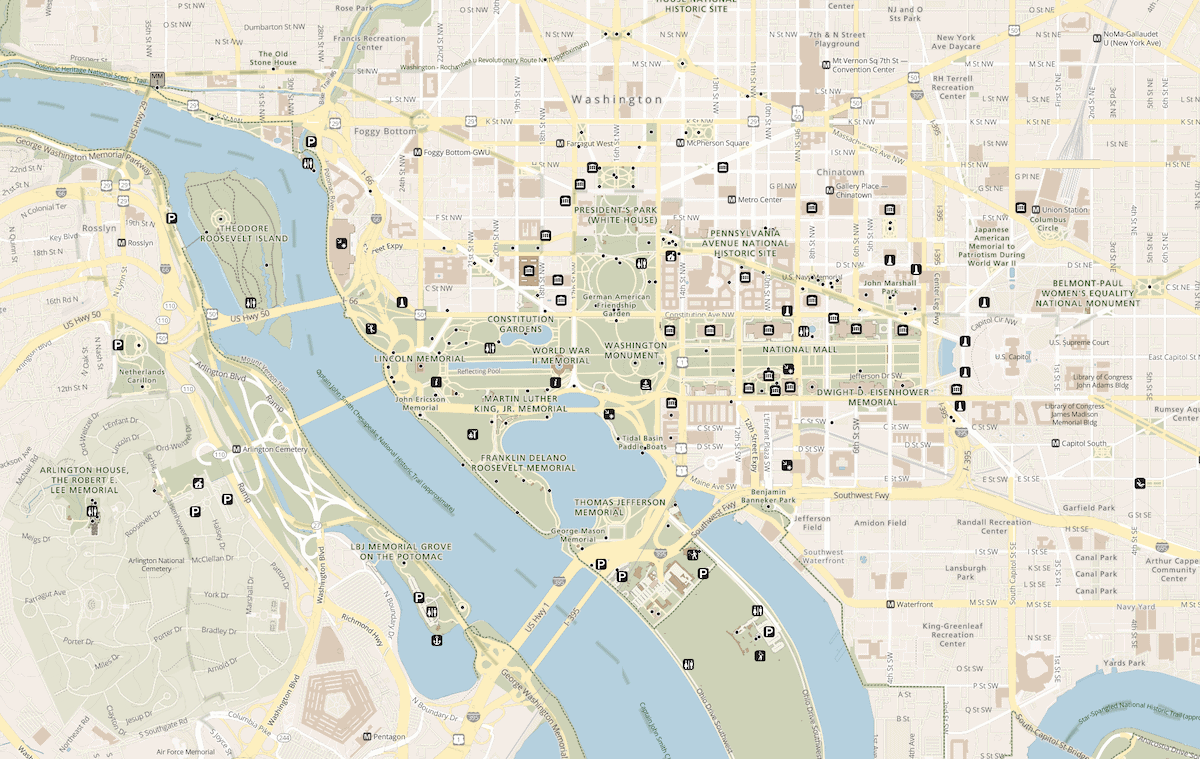
Need a restroom?
The NPS map also shows where public restrooms are such as at by the FDR Memorial, the Jefferson Memorial, the Lincoln Memorial, between the Vietnam Veterans Memorial and Constitution Gardens, the Washington Monument, and the World War 1 Memorial.
Nearby Attractions
On this trip, we did venture out for a hike at beautiful Great Falls Park where there are stunning waterfalls and a gorge where the Potomac River runs. Also, we drove to Mt. Vernon and spent a day retracing the steps of George Washington and learning more about him, his family, his business interests, and the history of those he enslaved. The Mt. Vernon docents (guides) are upfront about that part of history, by the way.
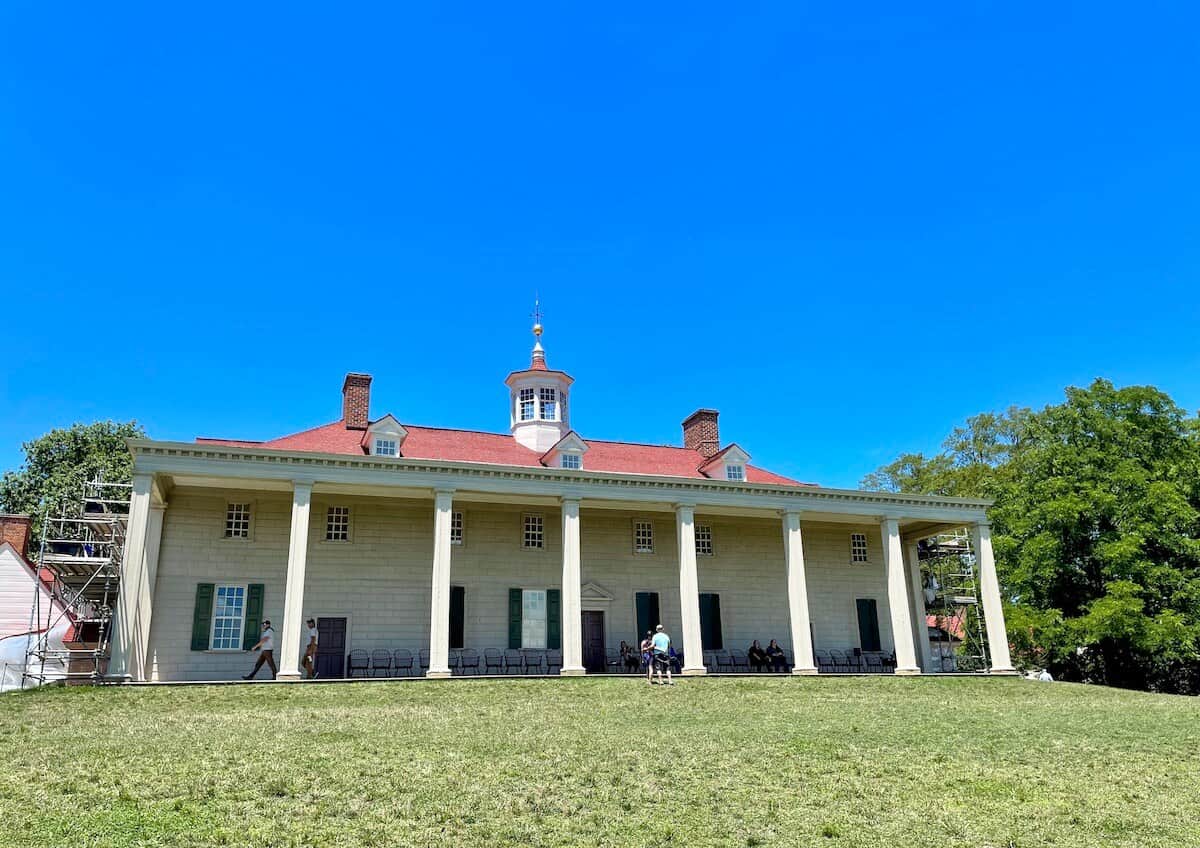
Less than an hour away is charming Annapolis which packs quite a few historical sites, sailing cruises, the U.S. Naval Academy (with tours available), public art, and incredible dining and shopping choices in a compact footprint of a city. There’s a lot to experience and Annapolis is very walkable; in fact, once you park your car, you can easily walk from place to place.
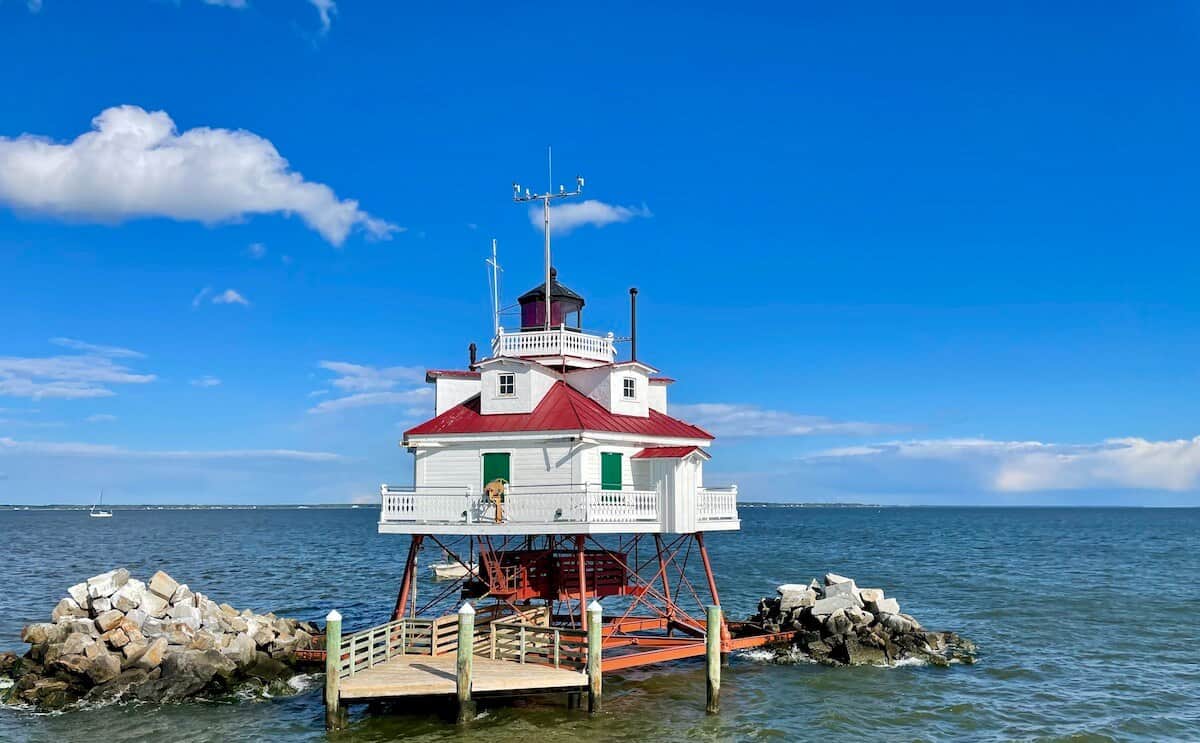
Further south are some wonderful spots in southern Maryland, on the western shore. Here you can discover and learn more about colonial history (Historic St. Mary’s City, a settlement dating to the 1600s, and St. John’s Site Museum); maritime history (four lighthouses to visit and the Calvert Maritime Museum), aviation history (Patuxent River Naval Air Museum with dozens of aircraft on display); natural history (fossil hunting at Calvert Cliffs State Park) plus great hiking, dining, and shopping options.
Final Thoughts
My husband and I were very familiar with Washington, D.C., and have visited plenty of times in the past. This time we decided we wanted to enjoy it as typical tourists as we walked from monument to monument. We especially enjoyed learning more about the symbolism built into some of the designs. That’s especially true in the powerful Martin Luther King, Jr. Memorial and the more recent World War II Memorial, and the Eisenhower Memorial.
As mentioned, we stayed in the District Wharf section which allowed us the freedom to explore part of the city on foot. Once we arrived and parked our car at the hotel, we didn’t have to worry about driving into the city and having to find a parking garage. While walking, we stopped on a bench along the way under large shade trees to munch on some snacks, sip water, and take in a little people-watching as others strolled by. All in all, a great way to take in these giant monuments to history.
Comments?
Please feel free to leave a comment (or email me) if you have ideas or suggestions for others visiting the area. Thank you! 🙂

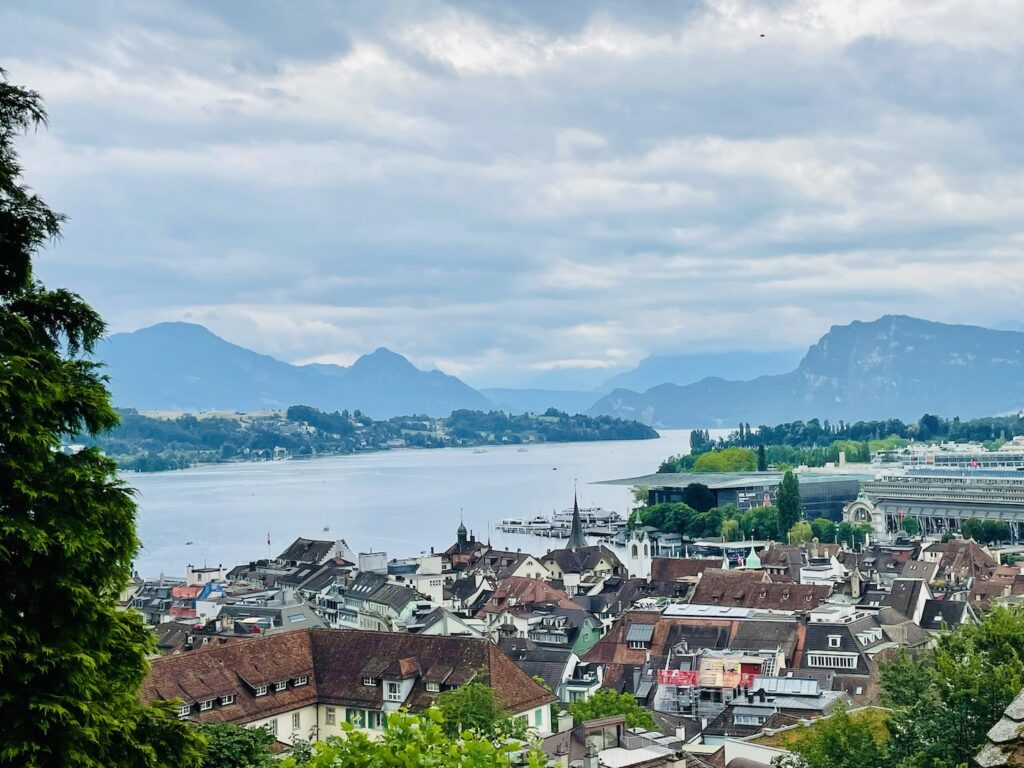
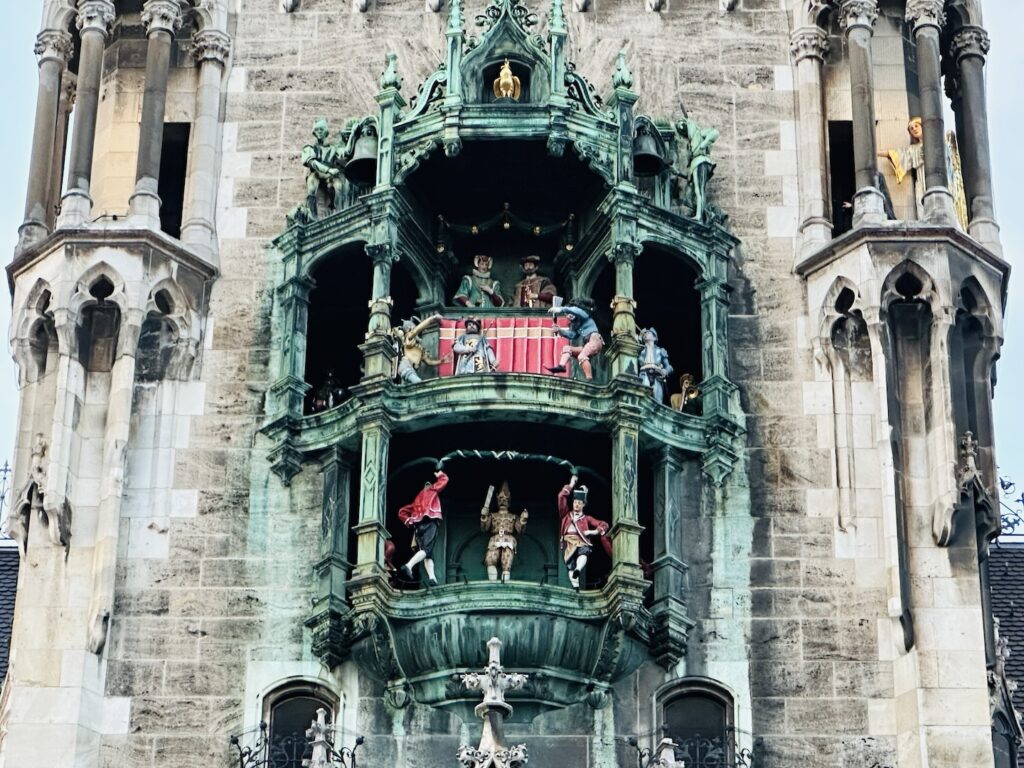


We stayed in DuPont Circle area last time we were in DC and liked it. It is near the Phillips Collection which is a must visit if you’re an art lover. Lots of good restaurants (not too stuffy) and shops in that area.
Glad you had a great time in D.C., Lily! It definitely has plenty of options for visitors.
At the Vietnam Memorial the soldiers were added only after controversy that the design of the main memorial was too dark and shameful. I prefer the original memorial by itself. The designer wanted us to see ourselves in the place of the fallen soldiers which is why it’s reflective. We can see the acceleration of the war as the monument rises up then shrinks back down near the end.
Thanks for sharing that information, Lauren. The Vietnam Memorial certainly has a lot of symbolism and is an important stop for visitors.